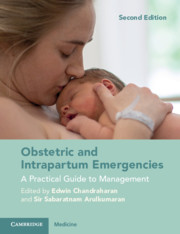Book contents
- Obstetric and Intrapartum Emergencies
- Obstetric and Intrapartum Emergencies
- Copyright page
- Contents
- Contributors
- Preface
- Preface to the First Edition
- Acknowledgements
- Section 1 General Principles
- Section 2 Algorithms for Management of the Top Five ‘Direct Killers’
- Section 3 Intrapartum Emergencies
- Section 4 Postpartum Emergencies
- Section 5 Medical and Surgical Emergencies During Pregnancy
- Section 6 Anaesthetic Emergencies During Pregnancy
- Section 7 Neonatal Emergencies and the Management of Immediate Neonatal Problems
- Section 8 Management of Anticipated and Non-anticipated Emergencies in Pregnancy
- Section 9 Setting-Up Skills and Drills Training in Maternity Services and Reducing Avoidable Harm
- Chapter 41 Addressing Human Factors in Obstetric Emergencies
- Chapter 42 Setting Up and Running Labour Ward Fire Drills
- Chapter 43 Simulation Training for Obstetric Emergencies
- Chapter 44 Learning from Mothers and Babies
- Chapter 45 Risk Management
- Index
- References
Chapter 43 - Simulation Training for Obstetric Emergencies
from Section 9 - Setting-Up Skills and Drills Training in Maternity Services and Reducing Avoidable Harm
Published online by Cambridge University Press: 06 May 2021
- Obstetric and Intrapartum Emergencies
- Obstetric and Intrapartum Emergencies
- Copyright page
- Contents
- Contributors
- Preface
- Preface to the First Edition
- Acknowledgements
- Section 1 General Principles
- Section 2 Algorithms for Management of the Top Five ‘Direct Killers’
- Section 3 Intrapartum Emergencies
- Section 4 Postpartum Emergencies
- Section 5 Medical and Surgical Emergencies During Pregnancy
- Section 6 Anaesthetic Emergencies During Pregnancy
- Section 7 Neonatal Emergencies and the Management of Immediate Neonatal Problems
- Section 8 Management of Anticipated and Non-anticipated Emergencies in Pregnancy
- Section 9 Setting-Up Skills and Drills Training in Maternity Services and Reducing Avoidable Harm
- Chapter 41 Addressing Human Factors in Obstetric Emergencies
- Chapter 42 Setting Up and Running Labour Ward Fire Drills
- Chapter 43 Simulation Training for Obstetric Emergencies
- Chapter 44 Learning from Mothers and Babies
- Chapter 45 Risk Management
- Index
- References
Summary
The use of simulation is a method of training for both individuals and teams. It allows learners to acquire skills in a non-threatening environment while avoiding harm to patients. It can be harnessed as a tool for learning a new skill or procedure through to exposing teams of experienced personnel to an innovative approach to develop or consolidate technical and non-technical skills incorporating teamwork skills.
Simulation-based training provides experiential opportunities for development of team cognition that may build upon, or even replace actual clinical experience, this being particularly beneficial for critical clinical incidents scenarios that are fortunately rare or uncommon within obstetrics, for example maternal cardiac arrest, amniotic fluid embolism and eclampsia as well as rehearsal for use of protocols, for example sepsis care bundles.
Information
- Type
- Chapter
- Information
- Obstetric and Intrapartum EmergenciesA Practical Guide to Management, pp. 311 - 314Publisher: Cambridge University PressPrint publication year: 2021
